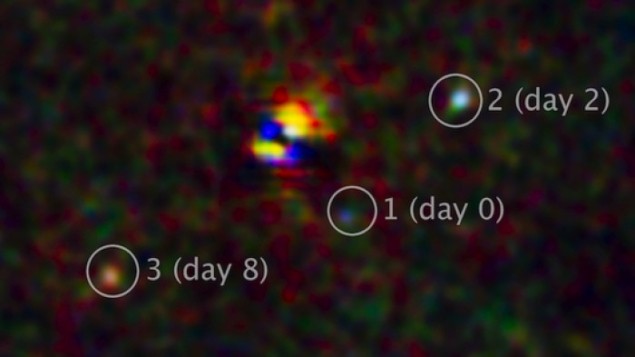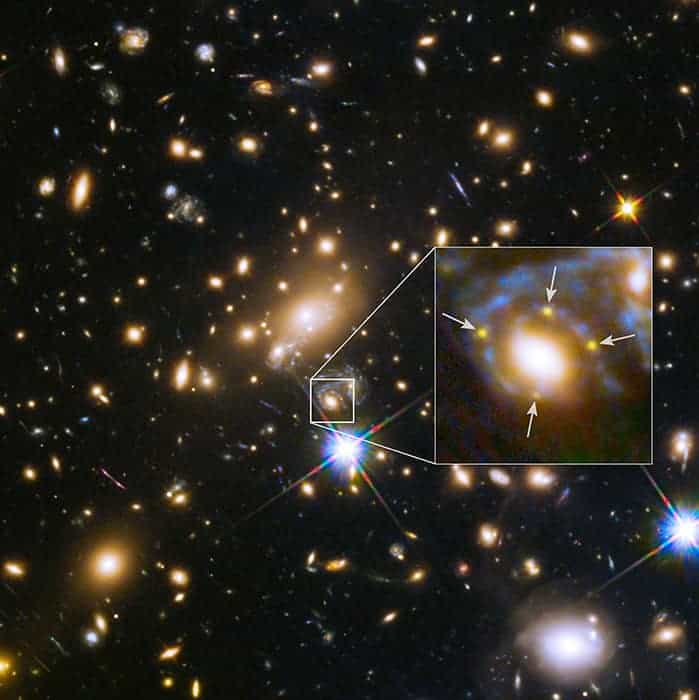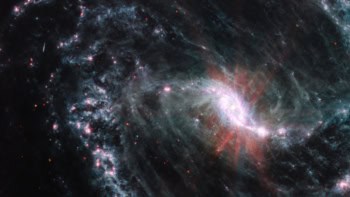
Light from a supernova that was emitted just six hours after the initial stellar explosion has been observed along with light emitted two and eight days later. The observation was made by an international team using the Hubble Space Telescope (HST). The supernova is also notable for having occurred around 11.5 billion years ago when the universe was in its relative infancy. The faint light could only be seen because of the gravitational-lensing effect of a galaxy that lies between Earth and the supernova.
The scientists, whose research is described in Nature, spotted the supernova in archival images from the HST. Light from the supernova was gravitationally lensed by the galactic cluster Abell 370, causing it to appear three times in the same image. The supernova occurred in a dwarf galaxy behind Abell 370.
“We found a distant supernova explosion in a single snapshot by NASA’s HST showing three different moments in its early stage of the explosion,” says Wenlei Chen, lead author of the Nature paper who is based at the University of Minnesota in the US. He tells Physics World, “Core-collapse supernovae like this one mark the death of massive stars, which are short-lived because they burn up quickly compared to stars with less mass.”
Red supergiant
When the core of the star exploded, a shockwave launched that heated the outer part of the star, causing it to expand and cool along the way. This gives rise to a light curve (how a star’s brightness changes over time) with a distinct shape that depends on the size of the star that exploded. From this, the team estimates that the radius of the progenitor star was around 530 times larger than that of the Sun, a size that is consistent with a red supergiant. The significant redshift of the star’s light curve means that the universe was just 2.2 billion years old when the supernova occurred.
“This is the first time that scientists have been able to measure the size of a dying supergiant star as it was more than 10 billion years ago,” Chen explains. “Usually, distant supernovae are too faint to be detected and identified using existing telescopes.”
Team member Jose Maria Diego of Spain’s Instituto de Física de Cantabria explains why this detection is so significant. “What makes this supernova special is that we are witnessing the first instants after the explosion,” Diego told Physics World. “Supernovae are also normally found much closer to us. This one is perhaps in the top five or so most distant supernovae ever observed.”
Diego also points out that these types of core-collapse supernovae are referred to as “standard candles” by astronomers because their light curves are so well-defined that they can be used to measure cosmic distances. This means that finding more early examples like this one could help test models of cosmic evolution.
Einstein’s theory
Indeed, this supernova is only visible because of a gravitational phenomenon that arises from Albert Einstein’s 1915 general theory of relativity. The theory says that a massive object such as a galaxy causes a significant deformation in nearby space–time and this deformation will bend the trajectory of light that passes near to the galaxy.
As a result, a galaxy can act as a gravitational lens that can focus light from a distant star towards Earth, giving astronomers a magnified view of the star. A gravitational lens can also create multiple images of the same star that are separated in space.
The massive lensing object responsible for making the distant supernova appear three times in the Hubble image is the galactic cluster Abell 370, which is located almost 5 billion light-years from Earth in the constellation of Cetus.
Time sequence
The light in each of the three images took different paths to Earth and these paths were of different lengths. This means that the images show the star at a sequence of three different times within eight days after the explosion.

Gravitational lensing creates ‘Einstein’s cross’ of distant supernova
“The fact that one of the images corresponds to just a few hours after the explosion is a remarkable discovery,” Diego adds. “We usually see supernovae days or weeks after they explode. Only supernovae that exploded near to us have been observed hours after the explosion. We have never before seen an early supernova at this distance.”
Chen says that the team plans to use the James Webb Space Telescope to further investigate the supernova and to search for more gravitationally lensed supernovae in the early universe. He adds that discovering more distant core-collapse supernovae should enable astronomers to gain a better understanding of star formation in the early universe.



